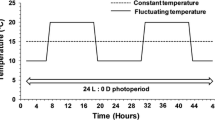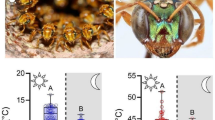Abstract
Since the temperature during development may affect growth and fitness in insects, climate change might affect important life history traits of solitary bees. We investigated the impact of three fluctuating and three constant temperature regimes on prepupal weight, mortality, and development time of Osmia bicornis. Prepupal weight decreased with increasing temperature, but not as strong under fluctuating conditions. Adult mortality increased in the warm treatments. Fluctuating (versus constant) temperatures accelerated development in the most stages and temperature regimes. The duration of almost all developmental phases decreased with increasing temperature, except for the prepupal phase that was prolonged in the warm treatments. The differences in thermal responses to fluctuating vs. constant temperatures illustrated the importance of fluctuating temperatures in studies investigating potential consequences of climate change for insects, including pollinators.




Similar content being viewed by others
References
Atkinson, D. (1994) Temperature and organism size—a biological law for ectotherms? Adv. Ecol. Res. 25, 1–58
Atkinson, D. (1996) Ectotherm life history responses to developmental temperature. In: Johnston, I.A., Bennett, A.F. (eds.) Animals and temperature. Phenotypic and evolutionary adaption, pp. 183–204. Cambridge University Press, Cambridge
Ayres, M.P., Scriber, J.M. (1994) Local adaptation to regional climates in Papilio canadensis (Lepidoptera, Papilionidae). Ecol. Monogr. 64(4), 465–482
Bale, J.S., Masters, G.J., Hodkinson, I.D., Awmack, C., Bezemer, T.M., Brown, V.K., Butterfield, J., Buse, A., Coulson, J.C., Farrar, J., Good, J.E.G., Harrington, R., Hartley, S., Jones, T.H., Lindroth, R.L., Press, M.C., Symrnioudis, I., Watt, A.D., Whittaker, J.B. (2002) Herbivory in global climate change research: direct effects of rising temperature on insect herbivores. Glob. Change Biol. 8(1), 1–16
Beardmore, J.A. (1960) Developmental stability in constant and fluctuating temperatures. Heredity 14(3/4), 411–422
Beck, S.D. (1983) Insect thermoperiodism. Annu. Rev. Entomol. 28, 91–108
Bosch, J., Kemp, W.P. (2000) Development and emergence of the orchard pollinator Osmia lignaria (Hymenoptera: Megachilidae). Environ. Entomol. 29(1), 8–13
Bosch, J., Kemp, W.P. (2004) Effect of pre-wintering and wintering temperature regimes on weight loss, survival, and emergence time in the mason bee Osmia cornuta (Hymenoptera: Megachilidae). Apidologie 35(5), 469–479
Bosch, J., Vicens, N. (2002) Body size as an estimator of production costs in a solitary bee. Ecol. Entomol. 27(2), 129–137
Bosch, J., Vicens, N. (2006) Relationship between body size, provisioning rate, longevity and reproductive success in females of the solitary bee Osmia cornuta. Behav. Ecol. Sociobiol. 60(1), 26–33
Bosch, J., Kemp, W.P., Peterson, S.S. (2000) Management of Osmia lignaria (Hymenoptera: Megachilidae) populations for almond pollination: methods to advance bee emergence. Environ. Entomol. 29(5), 874–883
Bosch, J., Sgolastra, F., Kemp, W.P. (2010) Timing of eclosion affects diapause development, fat body consumption and longevity in Osmia lignaria, a univoltine, adult-wintering solitary bee. J. Insect Physiol. 56(12), 1949–1957
EEA (2008) European Environmental Agency, Impacts of Europe’s changing climate—2008 indicator-based assessment, EEA report no. 4. http://www.eea.europa.eu/publications/eea_report_2008_4.
Folguera, G., Mensch, J., Munoz, J.L., Ceballos, S.G., Hasson, E., Bozinovic, F. (2010) Ontogenetic stage-dependent effect of temperature on developmental and metabolic rates in a holometabolous insect. J. Insect Physiol. 56(11), 1679–1684
Freitas, B.M., Pereira, J.O.P. (2004) Solitary bees: conservation, rearing and management for pollination. Universidade Federal do Ceará, Ceará, Brazil
Hagstrum, D.W., Milliken, G.A. (1991) Modeling differences in insect developmental times between constant and fluctuating temperatures. Ann. Entomol. Soc. Am. 84(4), 369–379
IPCC (2007) Intergovernmental Panel on Climate Change, Fourth Assessment Report (AR4): Climate Change 2007. IPCC Secreteriat, Genf
Jones, J.C., Myerscough, M.R., Graham, S., Oldroyd, B.P. (2004) Honey bee nest thermoregulation: diversity promotes stability. Science 305(5682), 402–404
Joshi, D.S. (1996) Effect of fluctuating and constant temperatures on development, adult longevity and fecundity in the mosquito Aedes krombeini. J. Therm. Biol. 21(3), 151–154
Kearns, C.A., Inouye, D.W., Waser, N.M. (1998) Endangered mutualisms: the conservation of plant-pollinator interactions. Annu. Rev. Ecol. Syst. 29(1), 83–112
Kemp, W.P., Bosch, J. (2005) Effect of temperature on Osmia lignaria (Hymenoptera: Megachilidae) prepupa–adult development, survival, and emergence. J. Econ. Entomol. 98(6), 1917–1923
Kemp, W.P., Bosch, J., Dennis, B. (2004) Oxygen consumption during the life cycles of the prepupa-wintering bee Megachile rotundata and the adult-wintering bee Osmia lignaria (Hymenoptera: Megachilidae). Ann. Entomol. Soc. Am. 97(1), 161–170
Kremen, C. (2008) Crop pollination services from wild bees. In: James, R.R., Pitts-Singer, T.L. (eds.) Bee pollination in agricultural ecosystems, pp. 10–26. Oxford University Press, Inc., Oxford
Menzel, A., Sparks, T.H., Estrella, N., Koch, E., Aasa, A., Ahas, R., Alm-Kubler, K., Bissolli, P., Braslavska, O., Briede, A., Chmielewski, F.M., Crepinsek, Z., Curnel, Y., Dahl, A., Defila, C., Donnelly, A., Filella, Y., Jatcza, K., Mage, F., Mestre, A., Nordli, O., Penuelas, J., Pirinen, P., Remisova, V., Scheifinger, H., Striz, M., Susnik, A., Van Vliet, A.J.H., Wielgolaski, F.E., Zach, S., Zust, A. (2006) European phenological response to climate change matches the warming pattern. Glob. Change Biol. 12(10), 1969–1976
Michener, C.D. (2000) The bees of the world. The John Hopkins University Press, Baltimore
Musolin, D.L., Tougou, D., Fujisaki, K. (2010) Too hot to handle? Phenological and life-history responses to simulated climate change of the southern green stink bug Nezara viridula (Heteroptera: Pentatomidae). Glob. Change Biol. 16(1), 73–87
Neumann, D., Heimbach, F. (1975) Das Wachstum des Kohlweißlings bei konstanten und tagesperiodisch wechselnden temperaturen. Oecologia 20(2), 135–141
Radmacher, S., Strohm, E. (2010) Factors affecting offspring body size in the solitary bee Osmia bicornis (Hymenoptera, Megachilidae). Apidologie 41(2), 169–177
Ratte, H.T. (1984) Temperature and insect development. In: Hoffmann, K.H. (ed.) Environmental physiology and biochemistry of insects, pp. 33–66. Springer, Berlin
Raw, A. (1972) The biology of the solitary bee Osmia rufa (L.) (Megachilidae). Trans. R. Entomol. Soc. Lond. 124(3), 213–229
Rombough, P. (2003) Modelling developmental time and temperature. Nature 424(6946), 268–269
Schwartz, M.D., Ahas, R., Aasa, A. (2006) Onset of spring starting earlier across the Northern Hemisphere. Glob. Change Biol. 12(2), 343–351
Sgolastra, F. (2007). Ecofisiologia del ciclo biologico di Osmia lignaria (Hymenoptera: Megachilidae). Unpublished doctoral dissertation, Facolta’ di agraria, Università di Bologna.
Sgolastra, F., Bosch, J., Molowny-Horas, R., Maini, S., Kemp, W.P. (2010) Effect of temperature regime on diapause intensity in an adult-wintering Hymenopteran with obligate diapause. J. Insect Physiol. 56(2), 185–194
Steigenga, M.J., Fischer, K. (2009) Fitness consequences of variation in developmental temperature in a butterfly. J. Therm. Biol. 34(5), 244–249
Stephen, W.P., Undurraga, J.M. (1976) X-radiography, an analytical tool in population studies of the leafcutter bee Megachile pacifica. J. Apic. Res. 15(2), 81–87
Stillwell, R.C., Fox, C.W. (2005) Complex patterns of phenotypic plasticity: interactive effects of temperature during rearing and oviposition. Ecology 86(4), 924–934
Strohm, E., Daniels, H., Warmers, C., Stoll, C. (2002) Nest provisioning and a possible cost of reproduction in the megachilid bee Osmia rufa studied by a new observation method. Ethol. Ecol. Evol. 14(3), 255–268
Tasei, J.N. (1973) Observations sur le développement d’Osmia cornuta Latr. et Osmia rufa L. (Hymenoptera Megachilidae). Apidologie 4(4), 295–315
Tepedino, V.J., Torchio, P.F. (1982) Phenotypic variability in nesting success among Osmia lignaria propinqua females in a glasshouse environment: (Hymenoptera: Megachilidae). Ecol. Entomol. 7(4), 453–462
Welbers, P. (1975) Der Einfluß von tagesperiodischen Wechseltemperaturen bei der Motte Pectinophora. Oecologia 21(1), 31–42
Acknowledgements
We thank two anonymous reviewers for their constructive comments and suggestions on an earlier draft of this manuscript. We gratefully acknowledge financial support for Sabine Radmacher from the Universität Bayern e.V. through a Ph.D. fellowship.
Author information
Authors and Affiliations
Corresponding author
Additional information
Manuscript editor: Stan Schneider
Effets de températures constantes et fluctuantes sur le développement de l’abeille solitaire Osmia bicornis (Hymenoptera: Megachilidae)
Osmia bicornis / température / développement / changement climatique
Auswirkungen von konstanten und fluktuierenden Temperaturen auf die Entwicklung der solitären Biene Osmia bicornis (Hymenoptera; Megachilidae)
Osmia bicornis / Temperatur / Entwicklung / Klimawandel
Rights and permissions
About this article
Cite this article
Radmacher, S., Strohm, E. Effects of constant and fluctuating temperatures on the development of the solitary bee Osmia bicornis (Hymenoptera: Megachilidae). Apidologie 42, 711–720 (2011). https://doi.org/10.1007/s13592-011-0078-9
Received:
Revised:
Accepted:
Published:
Issue Date:
DOI: https://doi.org/10.1007/s13592-011-0078-9




